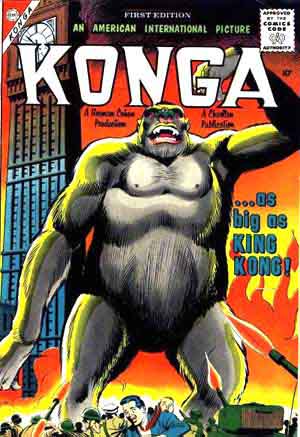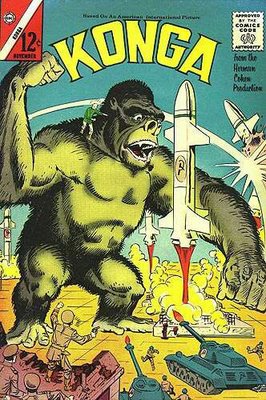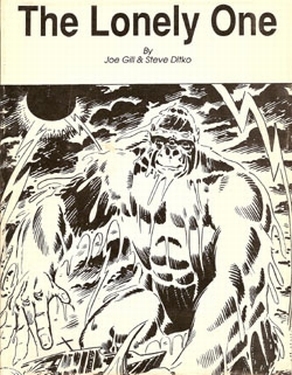 It’s amazing what the ongoing romance between academia and comics continues to offer.
It’s amazing what the ongoing romance between academia and comics continues to offer.
Case in point, this week saw the publication of writer Christopher Hayton‘s in-depth ode to a group of comicbooks I dearly loved as a kid, but never ever thought I’ve see get their due. Hayton’s excellent “Fantastic Giants: Charlton Comics’ Monster Movie Adaptations” was four years in the writing, and was just published in the online arts journal SCAN:
The title for Christopher’s essay is lovingly lifted from one of the great Charlton specials Fantastic Giants (1968), an all-Steve-Ditko one-shot that reprinted the Joe Gill/Steve Ditko first issue adaptations of the venerable early 1960s monster movies Gorgo and Konga, along with two original Ditko stories.
Hayton spotlights this fascinating chapter in ’60s comics history and Ditko’s career with an eye toward providing a proper context for these curious creature comics: “The history of comic books views the early 1960s largely in terms of the superhero revival, which certainly eclipsed Charlton’s monster movie adaptations, then and in the minds of historians today. But while superhero comics continue to be a mainstay of the mainstream comic book industry, an important corner of the modern market owes its origins to Charlton’s experiment with creature features. …A number of comic book industry greats worked at Charlton early in their careers, and the monster movie books showcase pencil work and inking by artists recognized today for their distinctive styles. Moreover, the extensive body of work of the books’ writer, Joe Gill, offers a rich field for analysis, as this article’s look at his monster movie adaptations will illustrate. The present article, then, seeks to draw the readers’ attention to Gill’s work as a source of natural social commentary, and also to the illustrative work of Charlton artists, particularly Steve Ditko, to be found in the monster movie books, in addition to the innovation that the books themselves accomplish in terms of genre founding.”
 One major oversight in Hayton’s otherwise comprehensive overview of movie comics that predate the Charlton monster comics of the ’60s must be noted: Dick Briefer‘s long-running Frankenstein comics (debuting in Prize Comics in the 1940s and landing it own title — two series! — through to the mid-1950s), which certainly owed a debt to the ongoing popularity of the bastardized Mary Shelley Frankenstein cinematic adaptations, spin-offs and endless procession of family members (Bride of, Son of, etc.). Briefer’s Frankenstein began as a straightforward horror series, then metamorphosed into a bizarre humor comic, returning to action-horror during the Pre-Code horror comics boom of the early ’50s.
One major oversight in Hayton’s otherwise comprehensive overview of movie comics that predate the Charlton monster comics of the ’60s must be noted: Dick Briefer‘s long-running Frankenstein comics (debuting in Prize Comics in the 1940s and landing it own title — two series! — through to the mid-1950s), which certainly owed a debt to the ongoing popularity of the bastardized Mary Shelley Frankenstein cinematic adaptations, spin-offs and endless procession of family members (Bride of, Son of, etc.). Briefer’s Frankenstein began as a straightforward horror series, then metamorphosed into a bizarre humor comic, returning to action-horror during the Pre-Code horror comics boom of the early ’50s.
In this, Briefer’s series also anticipated the Charlton monster comics; though the Charlton’s never became out-and-out cartoony, Joe Gill’s scripts did shift from sf/horror to absurdist humor, including an interspecies romance for Reptisaurus (successor to Reptilicus)!
 Steve Ditko gleefully embraced the humor elements Gill introduced to the pages of Konga in particular, including a running gag in one issue (featured in The Lonely One; see below) involving a photograph of an attractive couple seen reacting to the action of the story. It’s a bit like Gyro Gearloose‘s lightbulb-headed robotic assistant in the Carl Barks Donald Duck /Uncle Scrooge comics (particularly the Gyro Gearloose comics themselves) — you can follow their comedic interaction like a little ‘mini-movie’ hidden inside the panels.
Steve Ditko gleefully embraced the humor elements Gill introduced to the pages of Konga in particular, including a running gag in one issue (featured in The Lonely One; see below) involving a photograph of an attractive couple seen reacting to the action of the story. It’s a bit like Gyro Gearloose‘s lightbulb-headed robotic assistant in the Carl Barks Donald Duck /Uncle Scrooge comics (particularly the Gyro Gearloose comics themselves) — you can follow their comedic interaction like a little ‘mini-movie’ hidden inside the panels.
Konga was among Ditko’s most playful comics work ever, a stark contrast to the somber nature of Ditko’s most popular (Spider-Man, Dr. Strange) and most controversial (Mr. A) comics creations.
For the first time anywhere, Hayton analyzes the sales figures for the Charlton monster comics, and tallies their relative longevity in the marketplace by comparing Charlton’s annual sales figures for their three monster comics with sales figures from other major comics publishers, including those key titles Ditko made his mark in:
“The numbers reported are quite impressive. For Konga, the figures quoted were 187,778 (March 1963, average copies per issue in previous year), 112,700 (March 1964, average circulation per issue in previous year), and 234,331 (April 1965, average print run in previous year). For Gorgo it was 143,818 (February 1963, issues sold to paid subscribers in previous year), 231,676 (February 1964, average print run in previous year), and 184,778 (September 1965, average per copy distribution in the previous year). While interpretation of these figures is not necessarily straightforward, some comparisons can be made with other publishers from the same time period. Average paid distribution for issues of Superman (DC) in 1962 was 740,000, and for issues of Amazing Spider-man (Marvel) in 1966 was 340,215 (Miller 2009). However, a more realistic comparison would be with titles from similar genres: Mystery in Space (DC, 1962) averaged 190,000 copies, Unknown Worlds (ACG, 1963) 143,468, Turok, Son of Stone (Gold Key, 1963) 276,550, and Strange Tales (Atlas/Marvel, 1963) 189,305 copies per issue (Miller 2009). While distribution of the Charlton monster movie books did not reach the levels of the popular superhero books, their print runs compare well with comics of similar genre from the time period.”
 This kind of scholarly work is welcome, particularly for such previously-ignored (and indeed reviled) eddies in comics history. Growing up in Vermont, I was geographically close to Charlton’s base of operations (Connecticut), and Charlton titles had solid distribution even in the northern Green Mountain hinterlands. Hayton provides evidence of the wider popularity of the Charlton titles, and goes the extra mile to connect the Charlton 1960s monster movie comics with the contemporary industry standards, where their successors are popular fixtures of the comics market. Primary among those successors to Konga and Gorgo are the Dark Horse Aliens, Predator, and Aliens vs Predator, which indeed played a vital role in how the parent studio 20th Century Fox rebooted the film franchises themselves.
This kind of scholarly work is welcome, particularly for such previously-ignored (and indeed reviled) eddies in comics history. Growing up in Vermont, I was geographically close to Charlton’s base of operations (Connecticut), and Charlton titles had solid distribution even in the northern Green Mountain hinterlands. Hayton provides evidence of the wider popularity of the Charlton titles, and goes the extra mile to connect the Charlton 1960s monster movie comics with the contemporary industry standards, where their successors are popular fixtures of the comics market. Primary among those successors to Konga and Gorgo are the Dark Horse Aliens, Predator, and Aliens vs Predator, which indeed played a vital role in how the parent studio 20th Century Fox rebooted the film franchises themselves.
“The three Charlton movie monster adaptations appear to have been the first substantial examples of comic book series grounded in a sci-fi movie plot but then taken off in their own directions, in this case by prolific comic book writer Joe Gill, who admitted to having enjoyed working on Gorgo and the other movie comics… These titles set a successful precedent for later attempts by Marvel and other companies, who also created series based on sci-fi movies such as Logan’s Run, Planet of the Apes, Star Wars, Godzilla, 2001 A Space Odyssey, Alien, Predator, etc.”
 [Above, right: Dick Giordano cover art for the original Charlton Konga #1, interior art by Steve Ditko; left: one of Ditko’s own Charlton Konga covers, finding Konga typically taking on a communist country’s ‘weapons of mass destruction’]
[Above, right: Dick Giordano cover art for the original Charlton Konga #1, interior art by Steve Ditko; left: one of Ditko’s own Charlton Konga covers, finding Konga typically taking on a communist country’s ‘weapons of mass destruction’]
Alas, the 1960s comics Hayton writes about have long been collector’s items, and it’s almost impossible to find affordable individual issues, much less complete sets, of these vintage four-color fantasies.
Fortunately, we have in the Schulz Library a collection of the Gill/Ditko Konga comics stories, compliments of publisher Robin Snyder (by way of yours truly).
Beginning in 1989, Robin Snyder and Steve Ditko launched an ambitious series of modestly-formatted black-and-white volumes composed of vintage Ditko reprint and an abundance of brand-new original material from Ditko’s drawing board. We have a number of these collections in the Schulz Library, including an invaluable binder of Robin Snyder’s The Comics newsletter that offer the entire multi-chapter book by Steve Ditko detailing his years of freelance activity at Marvel Comics!
 The Joe Gill/Steve Ditko Konga collection Robin Snyder published in 1989 was The Lonely One, and it’s an excellent introduction to this oddball genre.
The Joe Gill/Steve Ditko Konga collection Robin Snyder published in 1989 was The Lonely One, and it’s an excellent introduction to this oddball genre.
The Lonely One reprints four issues of the Charlton title — Konga #8 and #11-13 — and it remains the only in-print collection of any title from this body of Charlton work.
In the context of its era, and of today, The Lonely One is unabashedly goofy reading. But given the John Stanley revival we’re enjoying, I honestly rank the Gill/Ditko Konga right up there with Stanley’s Melvin the Monster, though there’s a serious side to the Gill/Ditko work that sets it apart from Stanley’s satire.
Like Melvin the Monster, these were most definitely children’s comics — and I was just the kind of kid they were targetting — but Ditko’s artwork never condescended or ridiculed the narratives: in fact, the speed with which much of this was obviously executed fuels its primal immediacy and crude appeal. Gill and Dikto had their fun, but they were doing a monster comic — and when Konga was supposed to look formidable, he was as outsized and magnificent as any Jack Kirby monster! Springboarding directly from three iconic 1960s big-screen creature features, these were the true successors to the beloved Atlas/Marvel monster comics Ditko and Kirby labored over in the late ’50s and early ’60s, working with Stan the Man (Lee) and fellow pros Dick Ayers, Don Heck and others.
As already noted, Konga and The Lonely One also showcases some of Ditko’s most inventive and playful comics work to see print. There’s some truly antic work here, which always made Konga consistently the most fun ‘read’ in the entire Charlton stable. Though Gill and Ditko were always working against tight deadlines — they clearly full-tilt boogied through some of these issues, which sometimes determined how the stories and art would be executed (among my favorites: an entire issue of Konga in which the great ape spent most of the panels buried up to his neck in snow!) — Ditko always gave 100%, and some of the pen, brush and ink work in The Lonely One is still mighty sharp. It’s a treat to see it in black-and-white, evidently shot from the original art; it looks better than it did in the original Charlton comics (Charlton’s printing was infamously haphazard and often slipshod, sporting limited palettes of color).
Slim and compact as The Lonely One package is, it’s ideal for a summer afternoon. The intro by the late Pat Boyette is a treat too — Pat worked for Charlton from the mid-60s to Charlton’s demise in the ’80s, contributing to many of the same horror/mystery titles Ditko regularly appeared in — and there’s a Ditko checklist at the back of the volume.
Check out the other Steve Ditko/Robin Snyder volumes in the Schulz collection, while you’re at it… they’re all unique, to say the least!
– Stephen R. Bissette, Mountains of Madness, VT
 [If you want to read more about this strange period in Charlton Comics history, check out the Myrant multi-chapter essay on Charlton, their paperback division Monarch Books, and the incredible story of Reptilicus — the movie, the comic, and the sex (!) spiced paperback novelization that launched lawsuits and changed Reptilicus the comic series to Reptisaurus the comics series! Warning: saucy reading!:]
[If you want to read more about this strange period in Charlton Comics history, check out the Myrant multi-chapter essay on Charlton, their paperback division Monarch Books, and the incredible story of Reptilicus — the movie, the comic, and the sex (!) spiced paperback novelization that launched lawsuits and changed Reptilicus the comic series to Reptisaurus the comics series! Warning: saucy reading!:]

